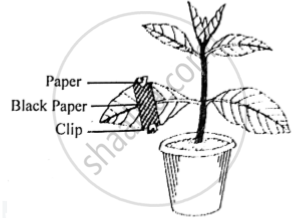Advertisements
Advertisements
Question
Respiration is said to be the reversal of photosynthesis.
Solution
Respiration is a catabolic process while photosynthesis is an anabolic process. During respiration, CO2 is given out while during photosynthesis O2 is given out.
APPEARS IN
RELATED QUESTIONS
The diagrams given below represent the relationship between a mouse and a physiological process that occurs in green plants. Study the diagrams and answer the questions that follow

(i) Name the physiological process occurring in the green plant that has kept the mouse alive.
(ii) Explain the physiological process mentioned above.
(iii) Why did the mouse die in bell jar B?
(iv) What is the significance of the process as stated in (i) for life on earth?
(v) Represent the above mentioned physiological process in the form of a chemical equation.
The diagram given below represents an experiment to prove the importance of a factor in photosynthesis. Answer the questions that follow : 
Name the factor studied in this experiment.
The following statement is about photosynthesis in a green plant. Write whether it is True or False.
Land plants obtain their carbon dioxide from the atmosphere.
Complete the following by filling in the blanks numbered 1 to 10 with the appropriate word/term:
Photosynthesis involves light reaction and dark reaction. During light reaction, the chlorophyll present in the (1) ______ gets activated by absorbing light energy. This energy splits (2) ______ molecules to (3) ______ and oxygen and releases two electrons. This process is called (4) ______. The (5) ______ ions are picked up by NADP to form (6) ______. The ADP is converted to (7) ______. This process is called (8) ______. During the dark phase, the compound produced at the end of the light reaction reacts with carbon dioxide to form (9) ______. This product is converted to starch. The process is called (10) ______.
The number of water molecules required in the chemical reactions to produce one molecule of glucose during photosynthesis is
A plant is kept in a dark cupboard for 48 hours before conducting any experiment on photosynthesis in order to
Are the following statement true or false? Give a reason in support of your answer.
If you immerse a leaf intact on the plant in ice cold water, it will continue to photosynthesise in bright sunshine.
The figure given below is for performing an experiment on photosynthesis.

Answer the following:
(i) What is the aim of this experiment?
(ii) Describe an experiment to show that light is necessary for photosynthesis.
(iii) What do you conclude from this experiment?
(iv) What is the role of light in photosynthesis?
Explain the Term Calvin Cycle.
Explain the term Phosphorylation.
Name the following:
The immediate product of photosynthesis.
Complete the following sentence with appropriate word:
One of the products of ______of water is oxygen.
Mention, if the following statement is True or False. If false rewrite the wrong statement in its correct form:
Photosynthesis can also occur n artificial light such as that of a 100-watt electric lamp.
Choose the Correct Answer:
A plant is kept in a dark cupboard for about 48 hours before conducting any experiment on photosynthesis to:
Choose the correct option.
Energy is transferred from the light reaction step to the dark reaction step by ______.
Planting trees help in decreasing global warming.
To which directional stimuli do
- roots respond
- shoots respond?
Higher Order Thinking Skill.
Imagine that student A studied the importance of certain factors in photosynthesis. He took a potted plant and kept it in dark for 24 hours. In the early hours of the next morning, he covered one of the leaves with dark paper in the centre only. Then he placed the plant in sunlight for a few hours and tested the leaf which was covered with black paper for starch.
- What aspect of photosynthesis was being investigated?
- Why was the plant kept in the dark before the experiment?
- How will you prove that starch is present in the leaves?
- Name the raw materials needed for photosynthesis.
______ is ATP factory of the cells.
Name the minute openings seen on the lower surface of the leaf.
